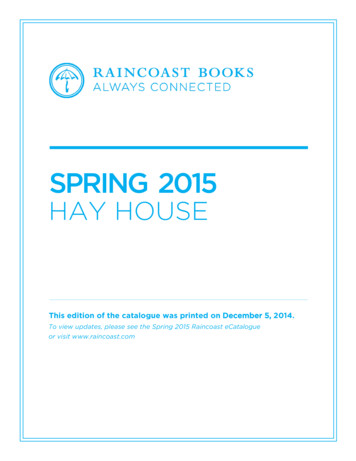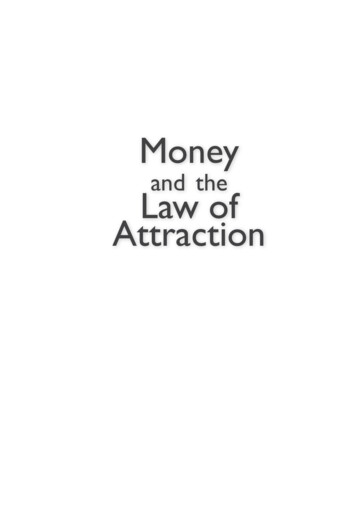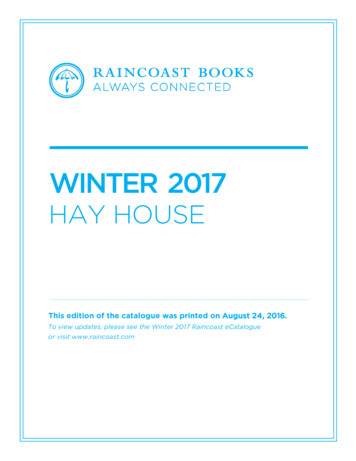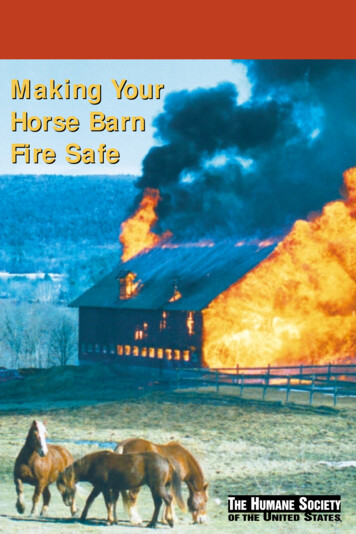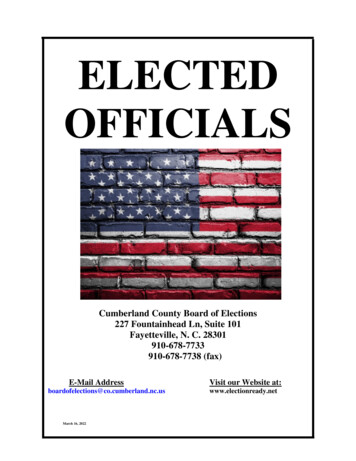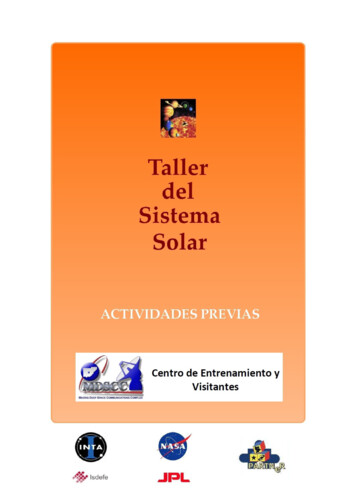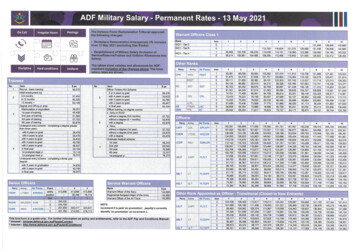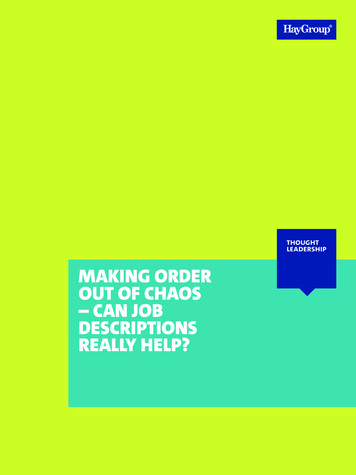
Transcription
thoughtleadershipMAKING ORDEROUT OF CHAOS– CAN JOBDESCRIPTIONSREALLY HELP?
CREATEPRESENTATION,WRITEJOB ,REPLY TOEMAILS,WRITEJOB DESCRIPTION,POST ATWEET,WRITEJOB DESCRIPTION,CHECKEMAILSAGAIN.RECOGNIZE THIS?Departments are being restructured,new roles have been created andexisting roles need to change.You know you and your line managerswill have to write new job descriptionsbut simply can’t face it.Where are the old job descriptions?What needs to be in the new ones?Can’t I just cut and paste?For HR and line managers alike, this is aday-to-day reality. The pain is especially acutein fast-growing organizations where peoplemanagement processes may not have keptpace with the rapid rate of change, and whoknows how long the new order will last.The pain isn’t confined here. Not many C-suitemembers would admit it, but many alsostruggle to understand the detail of what it istheir workforces actually do. They know howmany people they pay and where they work,but ask them what their actual jobs are andthe puzzled looks begin.1
A HOUSE BUILT ON SANDIn practice this leaves a multitude ofinconsistent job descriptions, poorly written,and bearing little relation to the actualresponsibilities, skills and behaviorsthat companies need from their people.It’s hardly a foundation for success.“I’ve been amazed over the years bythe number of organizations whoscratch their heads and say theydon’t know what they’ve got interms of their workforce”, says PhilJohnson, Head of Work Measurementat Hay Group. “They tell us that theyhave almost as many unique jobdescriptions as they have people andthat they need help streamliningthis and making it manageable. Weget projects to do that all around theworld. And as for job titles, that’s awhole other mess.”What’s the cause of all this chaos? Processesare often different, with everyone creatingjob descriptions in their own way, in theirown style. And there’s often no commondefinition and understanding of the skillsand behaviors demanded by any given role.Marketing teams are building consistentcommunications campaigns across theglobe, so why aren’t businesses doing thesame with their most important asset– their people?MARKETING TEAMS ARE BUILDINGCONSISTENT COMMUNICATIONSCAMPAIGNS ACROSS THE GLOBE,WHY AREN’T BUSINESSESDOING THE SAME WITH THEIR MOSTIMPORTANT ASSET – THEIR PEOPLE?BECAUSE JOB DESCRIPTIONS AREN’TIN THEIR JOB DESCRIPTION2
REMIND ME WHATTHEY’RE FOR AGAIN?69%OF THE BUSINESSESSURVEYED SAID INCORRECTJOB DESCRIPTIONSRESULT IN WASTED TIMEWITH IRRELEVANT CANDIDATESWITH THE WRONG SKILLS.58%OF HR MANAGERS GLOBALLY SAYPOOR JOB DESCRIPTIONSCAUSE EMPLOYEES TO LEAVE. 900millionSTAFF TURNOVER COSTS LARGEBUSINESSES IN THE UK(OF 500 EMPLOYEES)NEARLY 900 MILLION A YEARAND 4.5 BILLION YEAR IN THE US.Source: Hay Group research 2015,Poor job descriptions driving staff turnoverOne of the reasons job descriptions don’t getthe attention they deserve is that peoplehave lost sight of their number one purpose– to communicate what companies expect oftheir people in their jobs.Effective teams start with everyoneknowing what their role in the team is. Theideal job description should make it clearto the individual what they’re expectedto deliver, and give a sense of how theywill be evaluated at the end of the year. Itshouldn’t be too detailed, as it’s a statementof responsibility not an operating manual.“It’s where the rubber hits theroad when it comes to puttingbusiness strategy into practice,”says Phil. “With a structuredapproach that defines how youtalk about responsibilities, skillsand competencies, you’ll find ithelps running your organization,either implementing your newstrategy, or being more effective inyour operation because you’ve gotpeople who know what to do andare better suited to their roles.”Only a small number of specialist industriesactually need task-oriented job descriptions.The nuclear power industry is one, whereevery task or responsibility needs to beaccounted for in order for their business tooperate safely. But most organizations don’thave this excuse and focus too much onspecific tasks, rather than on what people areaccountable for and the competencies neededto perform the role successfully. A good jobdescription should focus on outputs and onthe skills and behaviors needed to achievethem.3
LAST ONE OUT TURNSOFF THE LIGHTSLOVE ATFIRST WRITEGet job descriptions wrong and thecost to businesses can be enormous.Firstly, there’s lost time. Withinthe recruitment process, 69% of HRmanagers believe they’ve wastedvaluable time with irrelevantcandidates because of wrong jobdescriptions1. Then there’s employeeretention. 58% of HR managersglobally say poor job descriptionscause employees to leave1. Thefinancial cost of turnover aloneis huge. With more than a third ofbusinesses having a staff turnoverrate higher than 21%, this costslarge businesses in the UK nearly 900 million a year. In the US, it’s astaggering 4.5 billion1.Of all the phrases least likely to be heardin the workplace, “I love writing jobdescriptions” must rank near the top.Then there’s the cost of your employees notknowing what they’re there for in the firstplace. Our research 2 shows that almost onein four employees express doubt over theirfirm’s direction and goals. But when peopleare clear on what’s expected of them, theyare more likely to deliver what you want.Most people genuinely want to do a goodjob and are prepared to invest time andeffort to get better at the things thatmatter. They also stay longer. So gettingjob descriptions right and matchingexpectations from the get-go helps.A consistent approach with a standardjob description template gives a companyclarity over what their people do, which iscrucial in helping to solve these importantpain points for organizations. If only theyweren’t such a pain to create.1) Source: Hay Group research 2015,Poor job descriptions driving staff turnover2) Source: Hay Group research 2013, Prepare for take off4Let’s face it, for line managers, it’s oftenseen as a chore and pushed to the bottomof their to-do list; for HR professionals,it can be a time-consuming distractionfrom doing more strategic work. Maybeeven seen as a necessary evil, only filled inbecause of company policy or because therecruitment process requires it.CREATING A JOBDESCRIPTION –OF COURSE,NO PROBLEMIT’S ON MY LIST.ISH ; (“It’s not only the time spent on jobdescriptions, but also the pain of worryingabout it,” says Phil Johnson. “It nagsaway and is a distraction.” Some put jobdescriptions on their to-do list and let themstay there until they’re forced to beginwriting. Others start with a blank pieceof paper – and stare at it or use unreliablesources, like the internet. Often, the task isjust given to the HR team.
CREATING A JOBDESCRIPTION –1.TOP PRIORITY2.LATER TODAY3.REMIND METOMORROW“It’s not only the time spent on job descriptions,but also the pain of worrying about it.It nags away and is a distraction.”says Phil Johnson5
FRAME IT THE RIGHT WAYAll of this angst detracts from one importantfact: job descriptions are an essential toolin helping you get the most from yourpeople. And despite people often feelingthat their job description should be uniqueto them, this is a common misconception,believes Phil Johnson. “Once we establishthe principle that a company doesn’t need1,000 unique job descriptions – perhaps itneeds only 100 – then we can start makinga real difference,” says Phil. “So instead of57 different administration assistant jobdescriptions, we can create a frameworkwhere there are actually only two main jobs:an administration assistant and a senioradministration assistant.”DOING THETHINGS YOUARE BEST ATWithin this new framework, it becomeseasier to discuss career progression or dostrategic workforce planning – for example,seeing how many Key Account Managersmay be needed in five years. “By having amanageable set of job descriptions, humanresources functions have a platform to bemore strategic, and do things that are moreorganized than in the chaos of the past,”continues Phil.This also helps HR support managers.“Line managers will save time as there’sno longer a need to have lengthyconversations with HR before sittingdown to write the job description”, saysPhil. “They can get it all done and offtheir task-list straight away. This wayHR teams and managers spend lesstime on tactical tasks and more time ontheir most meaningful work.”CREATINGA JOBDESCRIPTIONTIME SPENT6
DESIGNINGA DO-ABLE JOBPHEW!The end goal is to create job descriptions forroles that people can succeed in. And nobodyknows what success looks like in a role betterthan the line manager. But how do they knowwhat the right candidate looks like on paper?Empowering them to translate the workneeded into an effective job description is key.For Phil Johnson, this means helpingmanagers create job descriptions that havethe right skills and competencies mappedagainst key responsibilities. And that theseresponsibilities call for a similar set of skillsand competencies so that you can find peoplewho can succeed in the whole job.“ACTIVATE JOB DESCRIPTIONActivate Job Description is an easyto-use tool that gives you and yourmanagers the best starting point tocreate great job descriptions, helpingyou build a consistent foundationacross your business. It provides over70 years of Hay Group expertise at thefingertips, automatically suggestingthe right skills and behaviors neededfor a role. Meaning that it’s mucheasier to start looking for the mostrelevant candidates. And as well asgetting the right people into the rightroles, senior leaders get a clear pictureof the roles, skills and competenciesthat exist within the business.If you are designing a role for a salesmanager, for example, there are certainbehavioral competencies you’ll need forsuccess such as resilience and influence.If you’re looking for these skills whenyou’re recruiting, you’ll have a betterquality candidate pool and a more reliablestarting point to find the right person.”7
7 WAYS A STANDARDFRAMEWORK FOR JOBDESCRIPTIONS CAN HELP.1.Gives organizations a consistentframework to be more flexible when planningtheir workforce and making strategic peoplechoices.2.Gives directors and senior managersclarity on the types of roles, skills andcompetencies within the business.3.Gives managers a great startingpoint to quickly and easily build great jobdescriptions that are consistent with thebusiness.4.Helps managers understand justhow different (if at all) a specific job is from ageneric set of jobs their company has, to makesure they use titles consistently and avoid jobdescription proliferation.5.Helps attract and recruit the rightpeople and reduce staff turnover throughcreating good job descriptions that accuratelyreflect what the role involves.6.Provides a clear pathway to careerdevelopment through highlighting the skillsand competencies needed for progression.7.Frees up time for HR teams to spend onadding value to the organization instead oftransactional tasks.“We’re putting tools into the handsof line managers,” says Phil.“Previously, they would take hoursto do a job description, havingconversations with their HR partner,which is all non-productive time.What’s worse, they might haveto do it over and over – todayfor recruitment, next month fortraining and then later in the yearfor performance management. Thisis about activating the line manageras part of the transformation of theservice-delivery model of HR. Notonly are we helping HR move awayfrom the transactional activities, it’smore efficient for everyone. We’velimited the amount of work neededwithin the job description process.”“LET US DO THE HARD WORK FOR YOU ANDYOUR MANAGERS. IF YOU’D LIKE TO KNOWMORE ABOUT ACTIVATE JOB DESCRIPTIONPLEASE Group@HayGroup 2015 Hay Group. All rights reserved.8
at Hay Group. "They tell us that they have almost as many unique job descriptions as they have people and that they need help streamlining this and making it manageable. We get projects to do that all around the world. And as for job titles, that's a whole other mess." What's the cause of all this chaos? Processes
